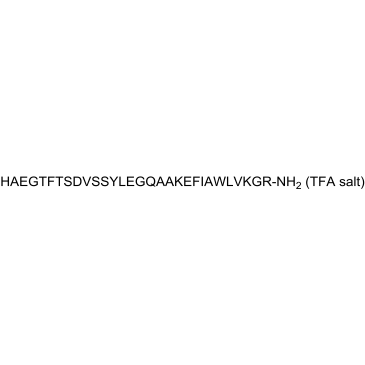- 产品详情
- 产品参数
- 产品评论
产品属性:
产品名称 | GLP-1(7-36), amide TFA |
规格 | 500μg、1mg、5mg、10mg |
货号 | EY-01Y12127 |
Cas No.: N/A
别名: N/A
化学名: N/A
分子式: C151H227F3N40O47
分子量: 3411.65
溶解度: N/A
储存条件: -20°C, protect from light
General tipsFor obtaining a higher solubility , please warm the tube at 37 ℃ and shake it in the ultrasonic bath for a while.
Shipping ConditionEvaluation sample solution : ship with blue ice
All other available size: ship with RT , or blue ice upon request
产品描述:
GLP-1(7-36), amide TFA is a major intestinal hormone that stimulates glucose-induced insulin secretion from β cells[1].Cells treated with phorbol 12-myristate 13-acetate for 2 h has significantly higher active GLP-1(7-36) Acetate (Human GLP-1-(7-36)-amide Acetate) concentrations in the media than those in the control. The glucose treatment also increases active GLP-1 secretion from cells in dose-dependent manner. Palmitic, oleic, linoleic or linolenic acid dose-dependently stimulated active GLP-1 secretion from cells. Active GLP-1 secretion is significantly greater with unsaturated fatty acids such as oleic, linoleic and linolenic acids than with palmitic acid. The treatment of NCI-H716 cells with CPE dose-dependently increases active GLP-1 concentrations in the media. A 37% increase is observed in active GLP-1 secretion from these cells at a concentration of 0.1 % CPE[1].Gastric administration of glucose increases active GLP-1(7-36) amide levels in the portal blood after 10 min, followed by a marked decrease at 30 min. The gastric administration of TO also increases active GLP-1 levels after 10 min, and followed by a decrease to basal levels at 60 min. Individually, glucose and TO increase the secretion of GLP-1 in a dose-dependent manner. Furthermore, the co-administration of glucose and TO additively increase peak GLP-1 levels. CPE-administered mice have higher active GLP-1 levels in the portal blood at 10 and 30 min than those in the control mice. When glucose is administered with CPE, active GLP-1 and insulin levels in the portal blood are slightly higher in CPE-administered mice than in the control mice. High-fat diet-fed C57BL/6J mice develop hyperglycaemia and impair glucose tolerance[1].[1]. Fujii Y et al. Ingestion of coffee polyphenols increases postprandial release of the active glucagon-like peptide-1(GLP-1(7-36)) amide in C57BL/6J mice. J Nutr Sci. 2015 Mar 3;4:e9.
特别提醒公司产品仅供科研使用
